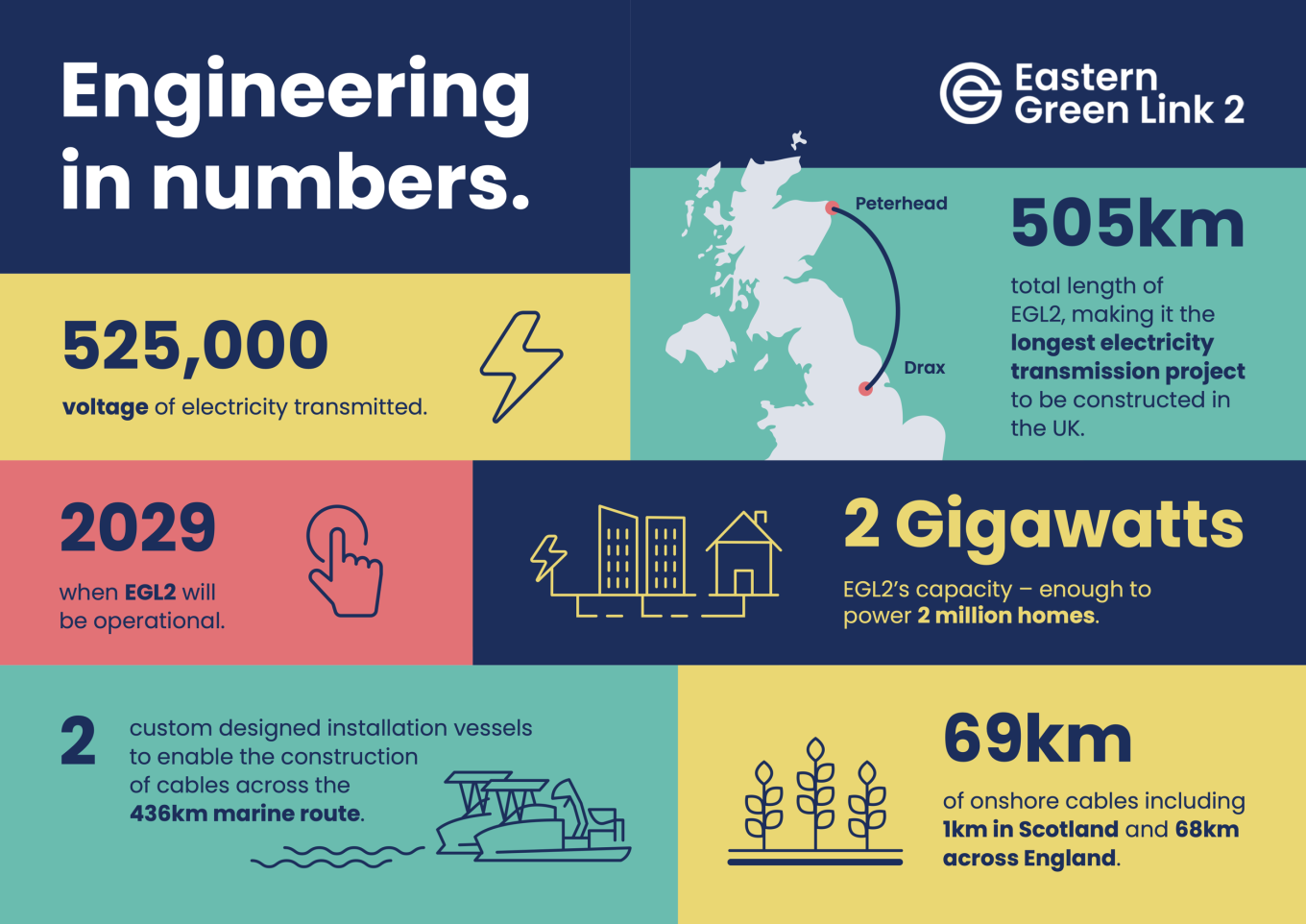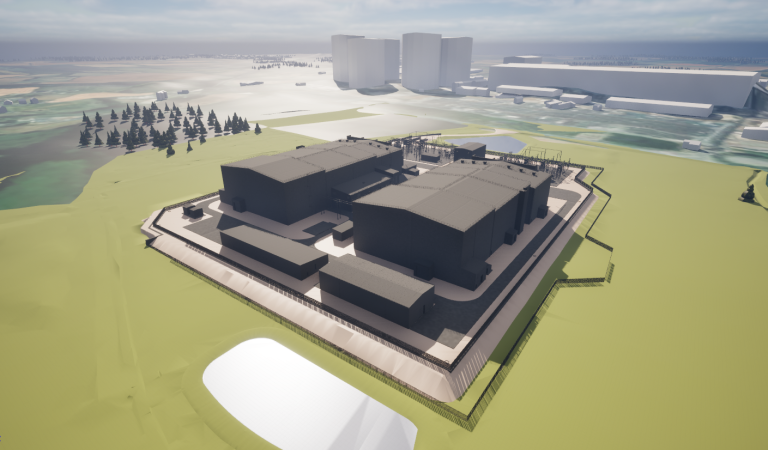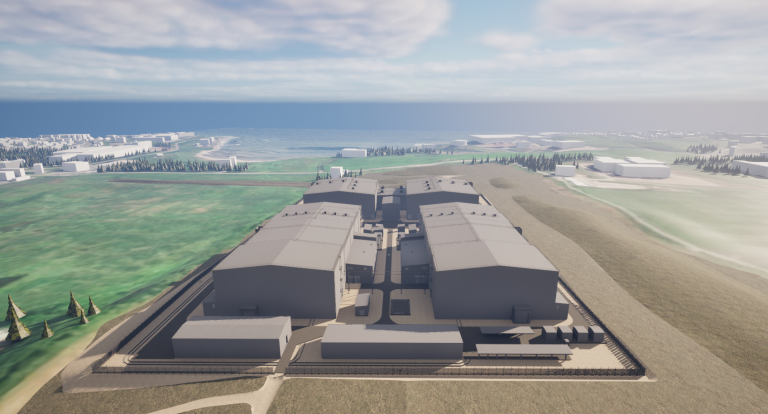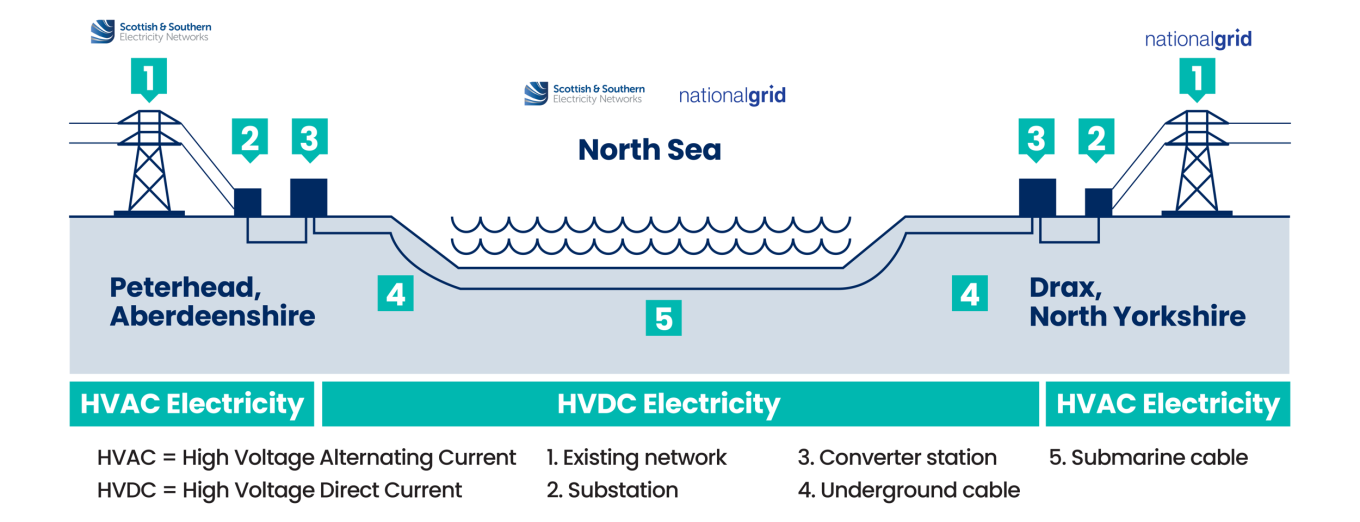Overview of EGL2
EGL2 is a 505km electricity superhighway which will enable the transfer of power from Scotland to England (and vice versa as required) via a subsea cable. The two-gigawatt, high voltage direct current (HVDC) cable is connecting Peterhead in Aberdeenshire and Drax in North Yorkshire.
EGL2 is being delivered as a joint venture between SSEN Transmission and National Grid Electricity Transmission (NGET).
For EGL2 we are building:
- Peterhead Converter Station in Aberdeenshire
- Approximately 1km of underground cabling from Peterhead Converter Station to Sandford Bay
- Approximately 436km of subsea cabling from Sandford Bay, Peterhead in Aberdeenshire to Fraisthorpe Sands, near Bridlington in the East Riding of Yorkshire
- Approximately 68km of underground cabling from Fraisthorpe to a converter station in Drax, North Yorkshire
- Wren Hall Converter Station in Drax
- Wider works:
- Peterhead Substation works – new bay in the existing substation
- Drax Substation works – new bay in the existing substation
- New 400kV cable system on the existing Drax to Eggborough Circuit
- New 400kV cable system southwards from Drax, terminating near Fenwick

Converter stations
A converter station houses the technology that converts electricity between alternating current (AC) and direct current (DC) and enables it to be transmitted over long distances. They are crucial switching points in the transmission system that ensure that electricity flows smoothly from where it is generated, to where it is needed.
For EGL2 there are two converter stations, one in Peterhead and one in Drax. The electricity generated by renewable sources, such as offshore wind farms, is sent through the AC network to the first converter station, where it is converted to DC to be transmitted via EGL2 high voltage direct current (HVDC) subsea cables. At the second converter station, electricity is then converted back to AC and introduced into the AC network, to be carried around the country via the wider transmission network.

Computer generated visual of Wren Hall Converter Station

Computer generated visual of Peterhead Converter Station

Needs case
Peterhead in Aberdeenshire, Scotland, and Drax in North Yorkshire, England, are both key hubs in the UK's energy landscape. Peterhead is an area that is becoming a hub for renewable energy generation, particularly from offshore wind, and Drax hosts a National Grid substation and overhead line infrastructure.
EGL2 is a critical component of the broader energy strategy for England and Wales. It is part of The Great Grid Upgrade, the largest overhaul of the electricity network in generations which aims to prepare the electricity network for a Net Zero future.
Pathway to 2030 is an equivalent blueprint for electricity transmission upgrades led by SSEN Transmission in Scotland. This scheme involves a further series of projects to increase capacity in the electricity transmission network in Scotland, to help meet UK and Scottish offshore wind targets of 50 GW and 11 GW respectively.
The project also supports the need for the UK to upgrade its electricity infrastructure helping to meet the challenges we face due to:
- Energy decarbonisation – as the UK continues to phase out fossil fuels, the electricity network must be capable of delivering energy from low carbon and renewable forms of generation, including offshore wind, to homes and businesses across the country
- Energy security – connecting the network to home-grown sources of generation will help to ensure our electricity network is self-sufficient and less reliant on imports
- Increasing demand – electricity demand in the UK is forecasted to double by 2050, meaning EGL2 is crucial to ensuring that the network can supply homes and businesses.
Working with our contractors
EGL2 is a collaborative effort with thousands of people from a range of organisations - big and small - working together to build the project. Of these organisations, there are three main works contractors which have responsibility for the delivery of EGL2 key infrastructure:
Hitachi Energy, a global leader in power technologies, is responsible for delivering the HVDC technology at our converter stations that will enable efficient long-distance bi-directional electricity transmission between Scotland and England.
BAM is an international construction and civil engineering company with extensive experience in delivering complex infrastructure projects. As a key contractor on EGL2, BAM is responsible for overseeing the construction of the converter stations at Peterhead and Wren Hall.
Prysmian is a global cable solutions provider leading the energy transition and digital transformation. On EGL2, Prysmian is responsible for the cable system design, manufacturing, and installation of the 436 km subsea cable, as well as the 69 km onshore underground cable in England and Scotland. To support the installation of EGL2’s onshore underground cable, Balfour Beatty has been subcontracted by Prysmian to deliver this key component of the project.
